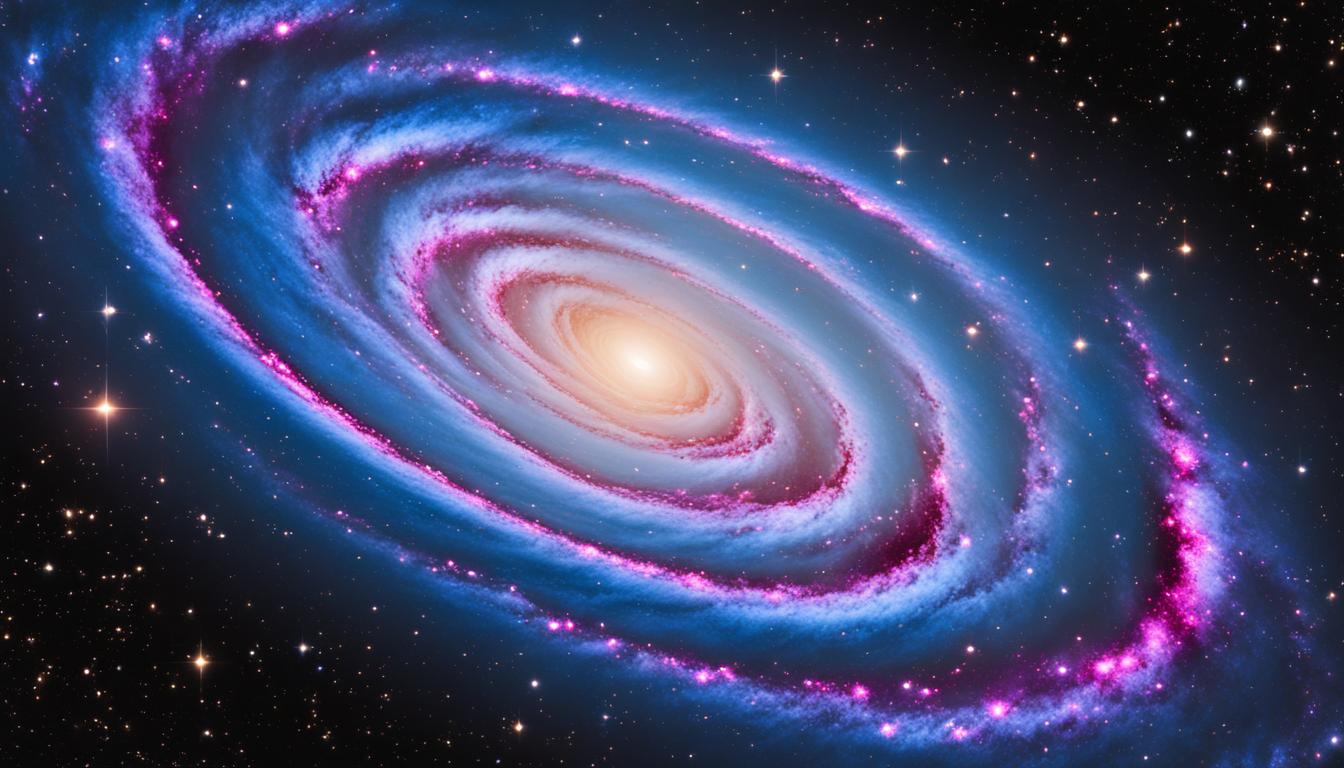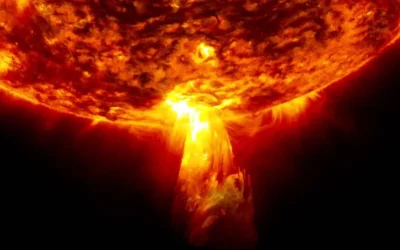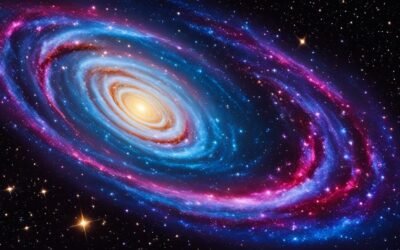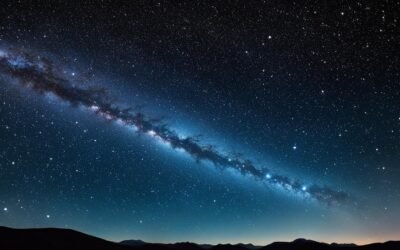As you gaze into the cosmos, your curiosity about astronomical objects draws you towards the fascinating realm of deep sky objects. Among these, the Messier 105 galaxy stands out as a monumental subject in space exploration. Residing approximately 36.6 million light-years away, within the Leo constellation, Messier 105 (M105) captivates the interests of astronomers and stargazers alike. Its elliptical majesty and rich history make it a beacon for scientific inquiry and celestial appreciation.
The discovery and subsequent studies of M105 have significantly contributed to our understanding of the universe. This galaxy not only serves as a testament to the tireless efforts of astronomers through the ages but also as a crucial piece in the astronomical puzzle that is the Messier catalog. Your journey through the stars brings you closer to comprehending the mysteries of Messier 105 and its importance in the tapestry of the night sky.
Key Takeaways
- Messier 105 is a notable elliptical galaxy within the constellation of Leo, an object of wonder for space exploration.
- M105 is distinguished by being the most prominent elliptical galaxy in the Messier catalog not part of the Virgo cluster.
- The galaxy’s core harbors a supermassive black hole, placing it among significant astronomical objects for study.
- Despite its elliptical nature, Messier 105 is known for a vast hydrogen ring suggestive of ongoing star formation.
- Messier 105’s inclusion in the Messier catalog and its history adds depth to the understanding of astronomical documentation.
- As part of the Leo I Group, M105 holds great value for elucidating the dynamics of galactic clusters and their constituents.
Discovering Messier 105: A Historical Perspective
The story of the Messier 105 galaxy is as captivating as the celestial object itself. On March 24, 1781, astronomer Pierre Méchain added another discovery to his record, shortly after unveiling the nearby galaxies M95 and M96. Within the vault of heaven, he identified what we now call Messier 105, yet this object initially slipped through the pages of the famed Messier catalog.
In an extraordinary turn of astronomical research, it was the astute eye of Helen S. Hogg that rectified this oversight. Upon finding Méchain’s letter, a key piece of historical evidence, M105 was rightfully pinned in the annals of space cataloging, aligning it with its first printed moniker, NGC 3379.
Today, thanks to these meticulous efforts, the Messier 105 galaxy occupies its rightful place in the esteemed Messier catalog, serving as a testament to the rich heritage of celestial discovery. As you gaze upon the night sky, remember that every star, planet, and galaxy comes with its own tale of pursuit and revelation—a narrative that often spans centuries and the lifetimes of dedicated observers.
Exploring Messier 105’s Location in the Constellation Leo
Embarking on a celestial journey to locate Messier 105, you’ll find this intriguing galaxy ensconced within the backdrop of the illustrious constellation Leo. A guide through the stars from the heart of Leo, Regulus, to the celestial abode of Messier 105 unfolds a pathway across the cosmos worthy of exploration by avid space enthusiasts and seasoned astronomers alike.
From Regulus to Messier 105: Charting the Path
Starting at the radiant Regulus, the brightest beacon in Leo, extend your gaze approximately 24 degrees eastward—towards Denebola—to uncover the elliptical marvel that is the Messier 105 galaxy. This astronomical object comfortably resides north of its close neighbors, Messier 95 and Messier 96, presenting a cosmic spectacle for those with a keen interest in space exploration.
Mark these coordinates — 10h 47m 49.6s right ascension and +12° 34′ 54″ declination — and you’ve pinpointed the exact location of Messier 105 among the stellar tapestry of constellation Leo. The thrill of spotting such celestial objects is matched only by the knowledge of their grandeur and the meticulous dance they perform in the vast cosmic arena.
Skywatching Tips: Best Times for Observing Messier 105
To observe the lustrous Messier 105 galaxy at its best, plan a stargazing escapade in the springtime when Leo ascends the nocturnal stage. The galaxy’s elliptical shape is most prominent when viewed through large binoculars or a telescope. A magnified lens reveals the neighboring galaxies NGC 3384 and NGC 3389 in the same field of view, although Messier 105’s mature elliptical nature may not exhibit extensive detail. It is a subtle reminder of the vast scale and variety that exists among the celestial bodies adorning our night sky.
As you engage in space exploration from the comfort of your backyard or local observatory, remember that the pursuit of astronomical objects like Messier 105 is more than a simple act of observation—it bridges the gap between our small existence and the infinite expanse, permitting a glimpse into the grand design of the universe.
The Significance of Messier 105 in astronomical research
When it comes to exploring the vast expanse of the universe, certain celestial objects attract more attention from astronomers than others. The Messier 105 galaxy is one such entity that has become a focal point in astronomical research. This galaxy is more than just a luminous spot in the sky; its characteristics and composition provide researchers with crucial data that aid in understanding the enigmatic nature of the cosmos.
As the purview of space exploration extends, the Messier 105 galaxy stands out as an archetype in galaxy classification. Classified as an E1-type elliptical galaxy, it exhibits almost perfect elliptical contours known as isophotes. This near-ideal shape, deviating by no more than 5°, hints at the galaxy’s serene structure, set apart by the absence of the fine structural details that many other galaxies typically display.
Messier 105 is distinguished by the intricate details that lead to a deeper comprehension of galactic evolution and behavior. Its halo reveals two distinct stellar populations, evoking questions about the galaxy’s intricate and turbulent past.
Furthermore, the nucleus of Messier 105 tells yet another compelling story. The existence of a linear-type active galactic nucleus categorizes it as having a weak active galactic nucleus (AGN), which points to negligible rates of accretion onto its central supermassive black hole. The scrutiny of these phenomena within Messier 105 enhances our grasp on both the architecture of astronomical objects and the dynamic processes that govern them.
| Characteristic | Description | Implication in Astronomical Research |
|---|---|---|
| Morphological Classification | E1-type elliptical galaxy | Serves as a benchmark in galaxy morphology and helps refine classification systems. |
| Isophotal Shape | Near-perfect elliptic | Provides insights into the stability and kinematics of celestial structures. |
| Stellar Populations | Presence of two distinct groups | Indicates a complex formation and evolution history, potentially involving galactic mergers. |
| Active Galactic Nucleus | Linear-type, weak AGN | Sheds light on accretion mechanisms and supermassive black hole activity in elliptical galaxies. |
Your understanding of the cosmos expands as you delve deeper into the characteristics of the Messier 105 galaxy. This beacon of light within the dark sky delineates the chronicles of the universe. Its traits contribute invaluable to the mosaic of knowledge that is space exploration and astronomical research, propelling our species further into the endless odyssey of discovery.
Messier 105’s Role in the Messier Catalog
As you delve into the world of astronomical objects, you’ll discover the curious case of Messier 105 (M105), a deep sky treasure that almost slipped through the historical cosmic records. The remarkable galaxy’s journey from obscurity to prominence within the Messier catalog is one shrouded in celestial serendipity and enhanced by the dedicated work of astronomers like Pierre Méchain and Helen S. Hogg. Understanding M105’s saga offers insight into the meticulous processes governing the cataloging of celestial wonders.
The Accidental Omission from Messier’s Original Catalog
Initially omitted from the celebrated Messier catalog, Messier 105 remained an enigma until fortune and astute scholarship reverse its fate of anonymity. Pierre Méchain’s discovery of this galaxy in 1781 was an essential contribution lost in translation through historic oversight, thus depriving M105 of early fame among its kin, such as the splendorous Andromeda and the magnificent Whirlpool galaxy.
Addition to the Messier Catalog: The Story Behind M105’s Inclusion
The inclusion of Messier 105 galaxy within the prestigious Messier catalog can be credited to the sharp intellect of Helen S. Hogg. Her discovery of a letter from Pierre Méchain elucidating M105’s existence bestowed upon this galaxy its rightful place among the catalog’s deep sky treasures. The recovery and subsequent recognition of M105 fortified the catalog and its reflection of the night sky’s richness.
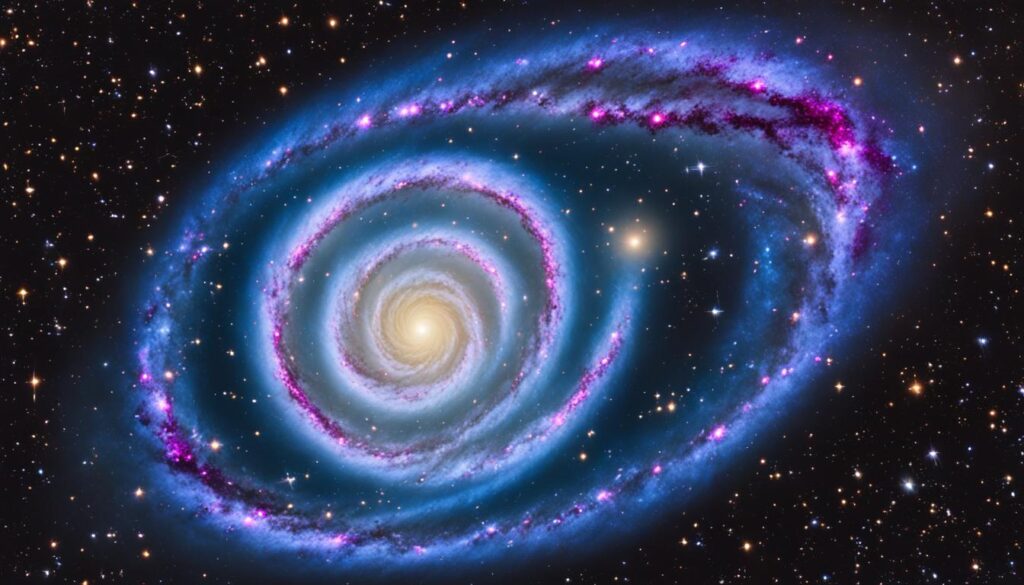
The Messier 105 Galaxy: A Deep Sky Treasure
Among the pantheon of celestial objects, the Messier 105 galaxy claims its place as a spectacle of the night sky. As an elliptical galaxy cataloged with the E1 classification, your gaze upon M105 is met by the glorious symmetry of deep space. This sprawling stellar entity is renowned for its graceful contours and understated elegance, sitting majestically as one of the illustrious deep sky objects discovered to date.
Messier 105’s Elliptical Brilliance
When you delve into the realm of galaxy classification, M105 emerges as a prime example of the standard elliptical galaxy shape with its characteristic flattening. This galaxy exhibits the textural finesse of an artist’s canvas—its isophotes are a testament to the geometric allure of the cosmos, boasting a consistency that captivates astronomers and enthusiasts alike.
What Makes Messier 105 Stand Out Among Celestial Objects?
Seated firmly within the core of Messier 105 lies a supermassive black hole, affirming its celestial might. The mass of this cosmic beast rivals up to 200 suns, firmly anchoring the galaxy as a standout amid the vast expanse. Housing a LINER type nucleus, M105 whispers of its dynamic cosmos events—subtle yet significant in their occurrence. The presence of young stars within M105 defies the expectations traditionally held for elliptical galaxies, suggesting an enduring capability for star formation, even if the pace is measured in the eons of time.
Discover the profound universe as the Messier 105 galaxy unveils its secrets, from the dance of young stars to the deep, undying hum of its supermassive black hole.
Navigating the Night Sky: How to Locate Messier 105
For those passionate about the wonders above, Messier 105 stands out as a captivating pursuit in celestial navigation. Situated far beyond our atmosphere are astronomical objects that tell stories of the cosmos’ past and present. Among these, Messier 105 is a must-see deep sky object for avid stargazers and amateur astronomers alike. As you set your sights on this magnificent elliptical galaxy, you’ll be embarking on a voyage through the cosmic ocean in search of one of the universe’s grand spectacles.
As a guide for your celestial navigation, you’ll find Messier 105 nestled within the Leo constellation, a constellation known for its bright stars and mythological significance. The galaxy is positioned on an imaginary line stretching east from the star Regulus towards Denebola. Here’s how you can monmark your astronomical journey:
- Become familiar with the constellation Leo, especially locating its brightest star, Regulus.
- Draw an imaginary line towards Denebola, the tail of the lion, and look northward.
- Messier 105 lies as part of the northern extension of the M96 Group of galaxies, ensuring it’s within reach of your telescope’s lens.
Remember, Persistence is key in celestial navigation, and the rewards of locating Messier 105 are immeasurable. You’ll not only have discovered a deep sky cornerstone but also honed your skills in tracing the mosaic of the night sky.
A Galactic Dance: Messier 105 and Its Cosmic Neighbors
Immersing yourself in the wonders of the cosmos, you’ll discover the Messier 105 galaxy, a lustrous gem in the celestial sea. Revered as a prominent player within the M96 Group, or the Leo I Group, this collection of deep sky objects showcases a majestic gravitational ballet performed across the canvas of space. Deep within the Leo constellation, these astronomical wonders weave an intricate narrative of cosmic kinship and evolution, with Messier 105 shining brightly as the assembly’s most luminous elliptical galaxy.
The M96 Group: A Local Cosmic Assembly
The Leo I Group harbors a treasure of galaxies, each contributing to the gravitational harmony of the M96 Group. As you embark on astronomical observation, the splendor of Messier 105 galaxy unfurls as a central force within this local group. Whispering the ancient secrets of the universe, M105’s radiant glow, coupled with the collective allure of this galactic ensemble, beckons to be unraveled through the lens of your telescope.
Celestial Neighbors: NGC 3384 and NGC 3389 in Proximity to Messier 105
Adjacent to the illustrious Messier 105 galaxy are its celestial companions, NGC 3384 and NGC 3389. These neighboring galaxies, while in close proximity, each tell a different tale. NGC 3384, with its barred lenticular structure, likely dances alongside M105 as a probable member of the M96 Group. Conversely, NGC 3389’s spiral arms pirouette in the background, offering a glimpse into the vastness of space beyond the group. Observers are treated to this cosmic menagerie, where each entity plays a critical role in the larger astronomical tapestry.
| Celestial Object | Type | Group Affiliation | Notes for Observers |
|---|---|---|---|
| Messier 105 (M105) | Elliptical Galaxy | M96 Group (Leo I Group) | Brightest galaxy in the group, best observed with a telescope. |
| NGC 3384 | Barred Lenticular Galaxy | M96 Group (Probable) | Close galaxy companion to M105, it adds contrast to the mostly elliptical members of the group. |
| NGC 3389 | Spiral Galaxy | Background Object | Although not a part of the group, its presence provides depth to the field of view. |
The Heart of Messier 105: Revelations of a Supermassive Black Hole
When you peer into the night sky and set your gaze upon the Messier 105 galaxy, you’re not just looking at a vast collection of celestial objects; you are also glimpsing a galactic mystery that has puzzled astronomers for years. Central to this enigma is the supermassive black hole lurking at the heart of Messier 105. This black hole is not just any cosmic feature—it is a behemoth that dictates the dynamics of the galaxy it dominates.
Velocity of Stars and the Black Hole Inference
Astronomical research indicates that the stars within Messier 105 are moving at incredibly high velocities, a clear sign that they are under the influence of a massive gravitational force. This observation is crucial, as it pieces together the puzzle that suggests the presence of a supermassive black hole. Imagine stars orbiting so rapidly, propelled by a gravitational sling from an invisible slingshot at the galaxy’s core. This slingshot, according to recent calculations, is believed to house a black hole with a mass upwards of 140 million suns.
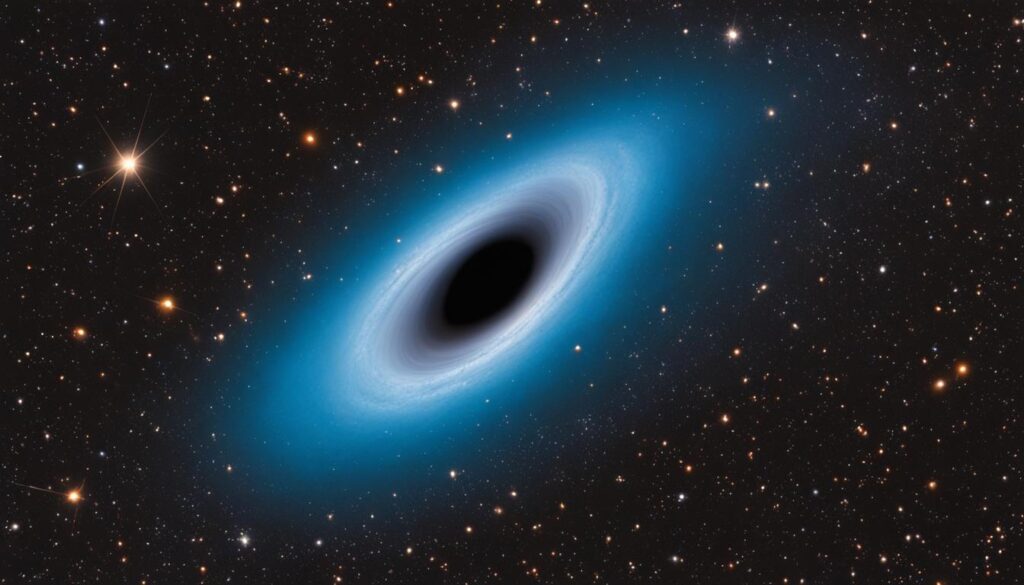
Comparing Black Hole Masses in the Universe
Within the vast tapestry of deep sky objects scattered across the cosmos, supermassive black holes are not uncommon. However, the one at the center of Messier 105 provides a unique case study in space exploration. With a mass that could potentially eclipse 200 million solar masses, it stands as a critical reference in comparing black hole masses throughout the universe. This monstrosity is an anchor point for understanding galactic evolution and the role these gargantuan black holes play in celestial ballet.
The revelations brought forth by the supermassive black hole within Messier 105 galaxy not only amplify the mystery surrounding these deep space colossi but also beckon further inquiry and exploration. As we continue to gaze into the heavens, seeking to understand our place in the universe, astronomical research like this shines a light on the complexities of the galaxies and the enigmatic supermassive black holes at their centers.
The Hidden Life of Elliptical Galaxies: Star Formation in Messier 105
When you gaze upon the vastness of space, elliptical galaxies like the Messier 105 galaxy may seem serene and unchanging, remnants of an earlier cosmic era. However, ongoing research uncovers layers of complexity, refuting the stagnant label often associated with these celestial bodies.
Discovery of Young Stars in an Ancient Galaxy
The discovery of young stars in a galaxy as mature as Messier 105 is reshaping our understanding of star formation within elliptical galaxies. Despite their reputation for being passive and dormant, these so-called “stellar fossils” house pockets of development indicative of ongoing star birth processes.
The Enigmatic Hydrogen Ring Surrounding Messier 105 and Its Companions
The existence of an expansive hydrogen ring encircling the Messier 105 galaxy and NGC 3384 is a testament to the dynamic nature of what we once considered inactive galaxies. This colossal structure, teeming with hydrogen gas – the fundamental building block of stars – is the arena for new star formation, slowly repopulating the galaxy with fresh stellar life. Observations suggest that the interaction between Messier 105, its neighboring galaxies like NGC 3389 and the ring itself, could be the catalyst for such late-stage galactic rejuvenation.
With each celestial revelation, your perception of the universe expands. The intricate dance between the record of ancient stars and the birth of new ones offers not just a glimpse into the life cycle of galaxies like Messier 105, but also into the ever-evolving portrait of our cosmos.
Messier 105: Telescopic Observations and Imaging
As you gaze into the expanse of space, telescopic observations and imaging play a pivotal role in unpacking the mysteries of celestial bodies like the Messier 105 galaxy. The insights gleaned from these tools have been instrumental in expanding our cosmic perspective, revealing deep sky objects in ever-greater detail. Most notably, the Hubble Space Telescope has afforded astronomers a profound understanding of the dynamic processes that rule the vast universe.
Hubble’s Insights into Messier 105’s Core
The power of the Hubble Space Telescope has brought the messier 105 galaxy into sharp focus, particularly illuminating the enigmatic core that is home to a supermassive black hole. Astronomical imaging conducted by Hubble has captured the essence of Messier 105, highlighting the rapid circulation of stars around its gravitational stronghold. This movement underscores the presence of the central black hole—astoundingly abundant with 200 million solar masses—epitomizing the fascinating and formidable engines that drive galaxies.
Advancements in Space Exploration and Messier 105
Your fascination with the heavens is met with the advancements in space exploration, elevating the role of telescopic prowess in celestial observation. With the evolution of astronomical equipment, Messier 105 has been characterized not as a mere static structure in the void, but as an active crucible of astrophysical phenomena. It stands as a testament to the ongoing astronomical research, with attributes that intrigue scientists and amateur stargazers alike. The journey through the night sky beckons, promising continuous revelation and wonder as humanity reaches for the stars.
FAQ
What is Messier 105?
Messier 105, also known as M105, is a large elliptical galaxy approximately 36.6 million light-years away in the constellation Leo. It is known for hosting a supermassive black hole and is a part of the Messier catalog, a list of deep sky objects compiled by astronomer Charles Messier.
Who discovered Messier 105 and when?
Messier 105 was discovered by French astronomer Pierre Méchain on March 24, 1781. While not originally included in the Messier catalog, it was later added after a letter by Méchain was found that mentioned this celestial object.
How can I locate Messier 105 in the night sky?
You can locate Messier 105 by starting at Regulus, the brightest star in the constellation Leo, and moving 24 degrees east towards the star Denebola. M105 is situated to the north of Messier 95 and Messier 96 in the sky.
What is the best time to observe Messier 105?
The spring season is the best time to observe Messier 105. It is visible with larger binoculars or a telescope and can be spotted in the constellation Leo alongside galaxies NGC 3384 and NGC 3389.
Why is Messier 105 important for astronomical research?
Messier 105 is important for astronomical research because it offers insights into the characteristics and dynamics of elliptical galaxies. It is home to a supermassive black hole, displays signs of new star formation, and challenges our understanding of how galaxies evolve.
What makes Messier 105 stand out in the Messier catalog?
Messier 105 stands out as the most significant elliptical galaxy in the Messier catalog not situated in the Virgo cluster. It is also distinguished by hosting a supermassive black hole and showing evidence of ongoing star formation despite its elliptical classification.
Does Messier 105 have any neighboring galaxies?
Messier 105 is part of the Leo I Group, also known as the M96 Group, and has nearby galactic neighbors like NGC 3384, a barred lenticular galaxy, and NGC 3389, a spiral galaxy, which enhance its astrophysical significance and are observable close by.
What does the presence of a supermassive black hole in Messier 105 indicate?
The presence of a supermassive black hole in Messier 105 is indicated by the high velocities of stars near its center. The black hole is estimated to have a mass between 140 and 200 million times that of our Sun and contributes to understanding galactic nuclei and their mass ranges.
Are elliptical galaxies like Messier 105 still forming new stars?
Yes, contrary to earlier assumptions about elliptical galaxies, Messier 105 has been observed to form new stars, although at a much slower rate than spiral galaxies. Its ability for star formation adds a new dimension to the study of such elliptical systems.
How does the Hubble Space Telescope contribute to our knowledge of Messier 105?
The Hubble Space Telescope has provided detailed observations of Messier 105’s core. Its high-resolution images allow astronomers to study the rapid movement of stars around the supermassive black hole and contribute to our understanding of the dynamics within the galaxy.



